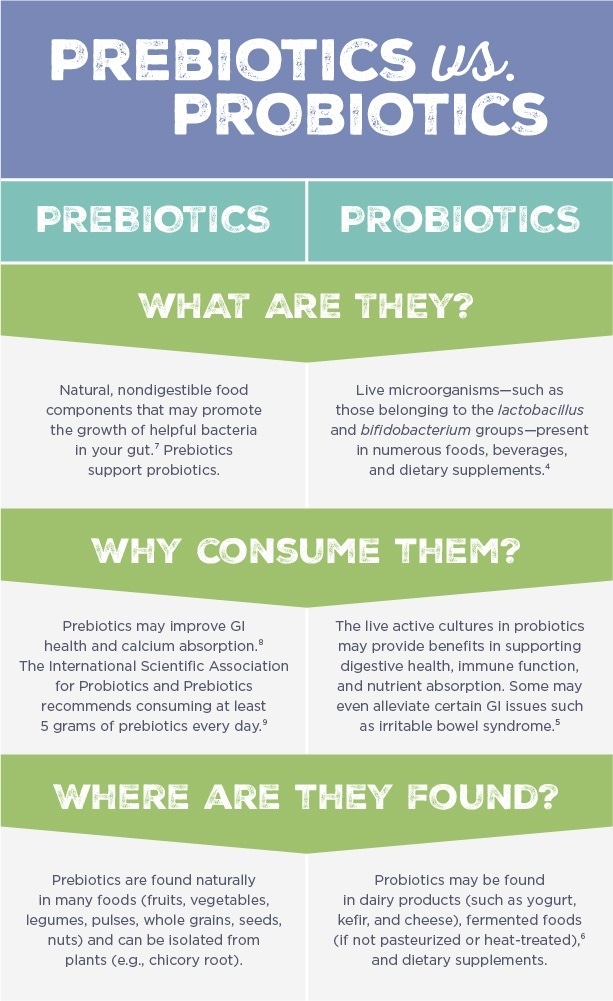Updated August 6, 2021
Did you know that gut health is connected to the health of the rest of your body? Your gut is filled with trillions of bacteria that play positive roles, such as aiding digestion and protecting against infection.1 Maintaining digestive wellness is important for our overall well-being.
Unfortunately, 60–70 million Americans suffer from digestive diseases, such as constipation, irritable bowel syndrome, and Crohn’s disease, according to the National Institutes of Health.2

The good news is that probiotics and prebiotics may provide benefits for digestive health through their interaction with the gastrointestinal (GI) tract.3 It’s no wonder so many people are talking about how to incorporate these food components into their diets.
The pros of probiotics and prebiotics.
Let’s learn more about probiotics and prebiotics—and how they can work together to keep your gut happy.

Prebiotic foods.
Here are some common foods that contain prebiotics:10
- Fruits: apples, bananas, berries, raisins, kiwi, guava, and pomegranate
- Vegetables: onions, garlic, leeks, shallots, artichokes, asparagus, tomatoes, mushrooms, and cabbage
- Legumes or pulses: lentils, dry beans, chickpeas, peas, and soybeans
- Whole grains: whole wheat, barley, rye, oats, brown rice, corn, and buckwheat
- Nuts and seeds: flaxseeds and almonds
- Other foods: honey, green tea, cassava (tapioca starch)
Probiotic supplements.
When choosing a probiotic supplement, be sure to check with your doctor about variety and quantity. You may need to find a specific probiotic strain that pairs best with your particular GI issue.11 Publix offers a variety of probiotic supplements.
Fermented food trends.
You may have seen fermented foods available in restaurants and at your neighborhood Publix. Though this form of probiotics may seem trendy and new, fermented foods have been part of human diets for thousands of years.12
What is fermentation? Fermentation is a process by which a microorganism transforms a food into another product. For example, yogurt is a fermented food made from milk. Lactic acid–producing bacteria grow in milk, changing the flavor, texture, and nutrients to create yogurt. The living cultures in fermented foods may add beneficial bacteria to the digestive tract.11
Here are some examples of fermented foods with active, living microbes:
- Dairy products: kefir, yogurt, and some cheeses
- Vegetables: fresh or raw kimchi, found in the Produce department; fresh sauerkraut and dill pickles, both found in the grocery/canned vegetables section
- Kombucha (kom-BOO-chuh): a traditional fermentation of sweetened tea made with a microbial mixture of yeast and bacteria, found in the Produce department or juices and drinks section.12
Fermented food tip. Fermented foods that are further processed by pasteurizing, baking, or filtering are no longer sources of active microbes. If you’re looking for fermented foods containing living cultures, keep your eyes peeled for terms on the label such as unpasteurized, naturally fermented, raw, or contains live and active cultures.
As research about the benefits of probiotics and prebiotics continues to evolve, there’s evidence to suggest that the right quantities of these food components can support gut health. It’s always wise to consult your physician about your particular needs. Publix offers a wide range of products and recipes to support your digestive health.
For the love of you.
Choosing how you eat is uniquely personal. It’s about your needs, your preferences, and your goals. As your wellness ally, we’re in your corner with fresh ideas, recipes, and wellness icons that make it easier to shift toward wiser food choices. It’s all about you, at your very best.
Sources
1 U.S. Department of Health & Human Services (HHS): National Institutes of Health. Your Microbes and You: The Good, Bad and Ugly. NIH News In Health. November 2012.
2 U.S. Department of Health & Human Services (HHS): National Institutes of Health. Digestive Disease Statistics in the United States. National Institute of Diabetes and Digestive and Kidney Diseases (NIDDK). November 2014.
3 International Food Information Council. 2020 Food and Health Survey. Food Insight. June 9, 2020.
4 U.S. Department of Health & Human Services (HHS): National Institutes of Health. Probiotics: What You Need To Know. National Center for Complementary and Integrative Health. August 2019.
5 Guglielmetti, S., D. Mora, M. Gschwender, and K. Popp. Randomized Clinical Trial: Bifidobacterium bifidum MIMBb75 Significantly Alleviates Irritable Bowel Syndrome and Improves Quality of life—A Double-Blind, Placebo-Controlled Study. Alimentary Pharmacology & Therapeutics 10, no. 33 (May 2011): 1123–32.
6 Probiotics. International Scientific Association for Probiotics and Prebiotics. Accessed June 28, 2021.
7 Klemm, Sarah, RDN, CD, LDN, ed. Prebiotics and Probiotics: Creating a Healthier You. Eat Right: The Academy of Nutrition and Dietetics. June 9, 2020.
8 Scholz-Ahrens, Katharina E., Peter Ade, Berit Martin, Petra Weber, Wolfram Timm, Yahya Açil, Claus C. Glüer, and Jürgen Schrezenmeir. Prebiotics, Probiotics, and Synbiotics Affect Mineral Absorption, Bone Mineral Content, and Bone Structure. The Journal of Nutrition 137, no. 3 (March 2007): 838S-846S.
9 Prebiotics. International Scientific Association for Probiotics and Prebiotics. Accessed June 28, 2021.
10 Hattner, Jo Ann, MPH, RD, and Susan Anderes, MLIS. Prebiotic Food Sources. Gut Insight. Accessed June 28, 2021.
11 Fermented Foods. International Association for Probiotics and Prebiotics. Accessed June 28, 2021.
12 Hutkins, Bob, PhD. Kombucha: Trend or New Staple? International Scientific Association for Probiotics and Prebiotics. September 18, 2017.

 You are about to leave publix.com and enter the Instacart site that they operate and control. Publix’s delivery and curbside pickup item prices are higher than item prices in physical store locations. Prices are based on data collected in store and are subject to delays and errors. Fees, tips & taxes may apply. Subject to terms & availability. Publix Liquors orders cannot be combined with grocery delivery. Drink Responsibly. Be 21. For prescription delivery, log in to your pharmacy account by using the Publix Pharmacy app or visiting
You are about to leave publix.com and enter the Instacart site that they operate and control. Publix’s delivery and curbside pickup item prices are higher than item prices in physical store locations. Prices are based on data collected in store and are subject to delays and errors. Fees, tips & taxes may apply. Subject to terms & availability. Publix Liquors orders cannot be combined with grocery delivery. Drink Responsibly. Be 21. For prescription delivery, log in to your pharmacy account by using the Publix Pharmacy app or visiting 
